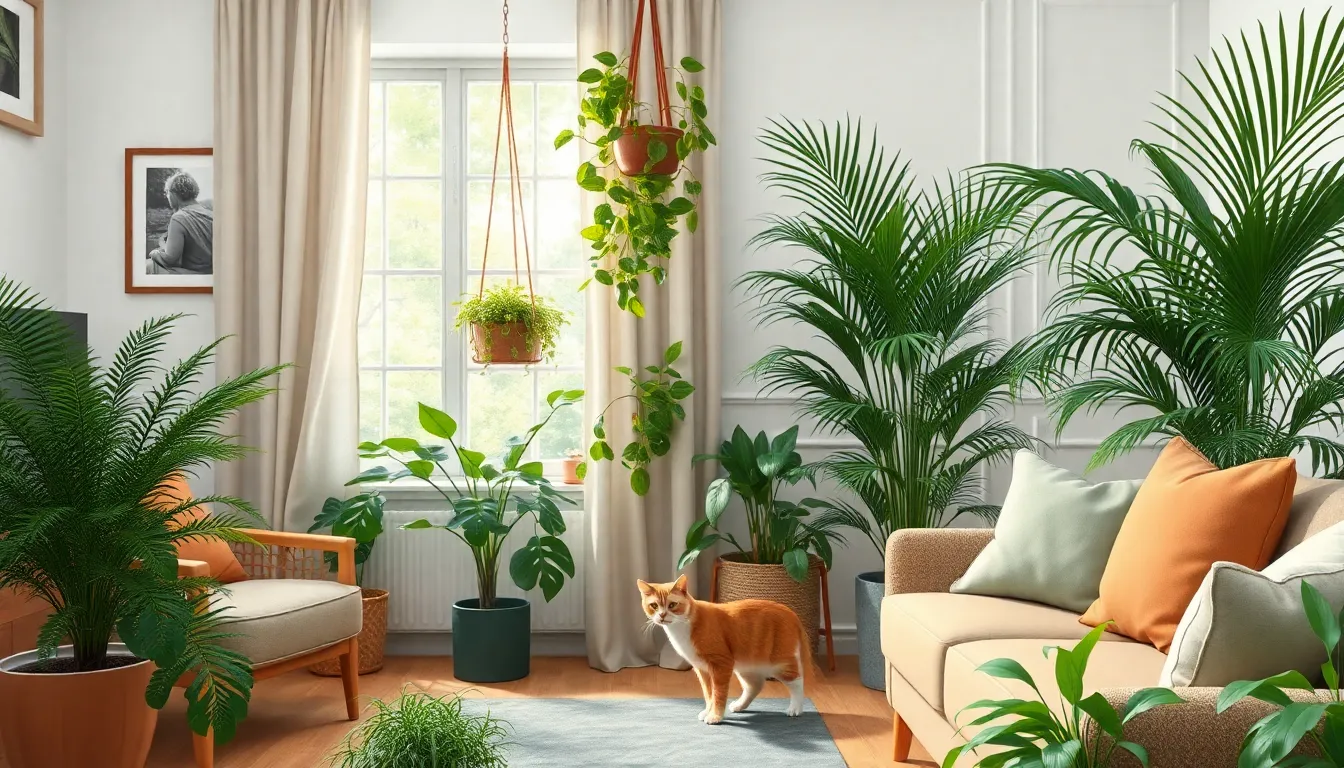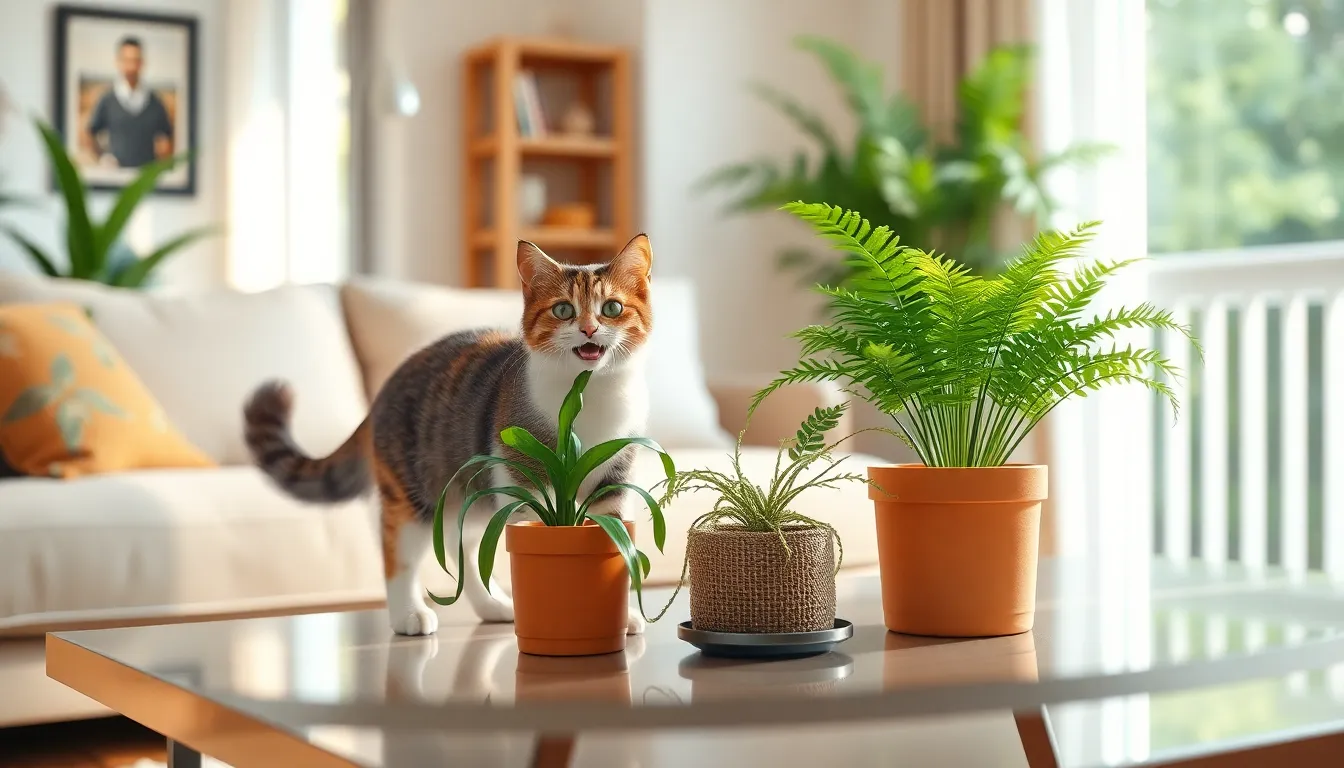Cats and plants can make a purr-fect pair, but not all greenery is safe for your feline friends. Imagine your cat eyeing your beautiful new houseplant like it’s the latest catnip craze—only to discover it’s toxic! That’s a recipe for disaster, and no one wants to be the cat parent with a plant graveyard.
Luckily, there’s a whole world of non-toxic houseplants that can brighten your home without putting your kitty at risk. From vibrant ferns to charming spider plants, these green companions are not just safe; they’re also stylish. So, why not create a lush indoor jungle that both you and your furry friend can enjoy? Let’s dive into the best non-toxic options that’ll keep your home looking fabulous and your cat safe.
Benefits Of Non Toxic Houseplants
Non-toxic houseplants offer significant benefits for both cats and their owners. They create a safe environment while enhancing the home’s aesthetic.
Health Benefits For Cats
Non-toxic plants contribute to a healthier living space for cats. They provide fresh air by filtering toxins and increasing humidity. Cats experience reduced stress when surrounded by greenery. Stress reduction leads to improved overall well-being. Additionally, these plants discourage harmful behavior like chewing on dangerous foliage. Owners can relax knowing their feline friends are safe and enjoying their environment.
Aesthetic Appeal For Homes
Non-toxic houseplants enhance the beauty of a home. A variety of options exists, from ferns to spider plants. Each type adds texture and color to any room. Incorporating these plants allows for a vibrant, inviting atmosphere. Style meets safety without compromising on design choices. Cats and owners share a peaceful space that remains visually appealing. Non-toxic plants create natural focal points that elevate interior décor.
Non Toxic Houseplants For Cats

Selecting non-toxic houseplants for cats creates a safe and inviting environment. Many plants enhance aesthetics while ensuring feline safety.
Spider Plant
Spider plants are a favorite choice for cat owners. They feature arching green leaves with white stripes, making them visually appealing. Cats love to play with the hanging foliage, and the plant’s safety supports worry-free interaction. Not only do spider plants purify indoor air, they also thrive in various light conditions. They require minimal care, making them perfect for busy households.
Boston Fern
Boston ferns add a lush, tropical feel to any indoor space. With their delicate fronds, these plants create an attractive backdrop in homes. They prefer humid environments, which helps maintain optimal moisture levels in the air. Cats enjoy their textured leaves, often playing around them without risk of harm. Boston ferns also filter air toxins, promoting a healthier living atmosphere for both cats and humans.
Areca Palm
Areca palms bring an elegant touch to home decor with their tall, feathery fronds. These graceful plants can grow up to 6-7 feet tall, allowing for dramatic decor statements. Cats appreciate the plant’s gentle sway with air movement, stimulating their curiosity. Additionally, areca palms help improve indoor air quality by filtering harmful substances. They thrive in bright, indirect sunlight and require moderate watering, making them manageable for most households.
Care Tips For Non Toxic Houseplants
Maintaining non-toxic houseplants requires understanding their specific needs. Proper care ensures vibrant growth while keeping a safe environment for cats.
Light Requirements
Different plants have varying light requirements. Spider plants thrive in indirect sunlight, adapting well to lower light conditions. Boston ferns prefer bright, indirect light but need protection from harsh sunlight. Areca palms do best in filtered light, growing taller in brighter spaces. Observing how plants respond can guide adjustments. For instance, if leaves begin to yellow, inadequate light might be the issue. Providing adequate light boosts health and aesthetic appeal, ensuring the plants flourish safely for curious cats.
Watering Needs
Watering practices vary among non-toxic plants. Spider plants enjoy a moderately moist soil, requiring water when the top inch dries out. Boston ferns need consistently moist soil, benefiting from frequent misting to maintain humidity. Areca palms prefer drier conditions, demanding less frequent watering—once the top few inches of soil dry. Overwatering leads to root rot, while under-watering creates stress. Monitoring soil moisture helps keep plants thriving and ensures safety for pets in the home. Regular assessments of plant needs promote healthy growth and a welcoming space for both cats and owners.
How To Introduce Plants To Your Home
Introducing non-toxic houseplants to a home with cats requires a thoughtful approach. By considering your cat’s habits and preferences, creating a harmonious environment for both pets and plants becomes achievable.
Gradual Introduction
Start with just one or two plants, allowing your cat to adjust to the new additions gradually. Over time, increase the number of plants while observing their reactions. Choose a designated area that’s out of reach for curious paws. Ensure plants are placed in stable pots to prevent accidental spills. Selecting hardy species, like spider plants or Boston ferns, supports successful integration into your home. Regularly rearranging plant positions can stimulate your cat’s interest, creating a dynamic environment.
Monitoring Your Cat’s Behavior
Pay close attention to how your cat interacts with the new plants. Notice if they show curiosity or attempts to chew on the leaves. Observing behavior helps in determining if a plant truly fits the environment. Some cats may exhibit interest without harming the plants, while others might chew on foliage. Redirecting unwanted behavior by providing cat grass or designated play areas encourages safe engagement. Tracking any changes in your cat’s behavior furthers understanding of their comfort and curiosity levels.
Conclusion
Choosing non-toxic houseplants is essential for cat owners who want to create a safe and beautiful home. These plants not only enhance the aesthetic appeal of indoor spaces but also promote a healthier environment for feline companions. By selecting varieties like spider plants, Boston ferns, and areca palms, pet owners can enjoy the benefits of vibrant greenery without compromising their cats’ safety.
Proper care and attention to each plant’s needs ensure they thrive while providing a calming atmosphere for both pets and humans. With thoughtful placement and monitoring, integrating these safe plants into a home can lead to a harmonious coexistence that nurtures the well-being of every family member.

